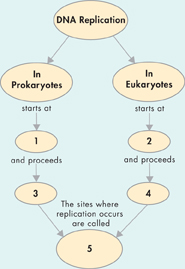12 Study Guide
 Information and Heredity, Cellular Basis of Life
Information and Heredity, Cellular Basis of Life
DNA is a double-stranded protein molecule made up of nucleotide base pairs. DNA stores, copies, and transmits the genetic information in a cell.
12.1 Identifying the Substance of Genes
 By observing bacterial transformation, Avery and other scientists discovered that the nucleic acid DNA stores and transmits genetic information from one generation of bacteria to the next.
By observing bacterial transformation, Avery and other scientists discovered that the nucleic acid DNA stores and transmits genetic information from one generation of bacteria to the next.
 Hershey and Chase's experiment with bacteriophages confirmed Avery's results, convincing many scientists that DNA was the genetic material found in genes—not just in viruses and bacteria, but in all living cells.
Hershey and Chase's experiment with bacteriophages confirmed Avery's results, convincing many scientists that DNA was the genetic material found in genes—not just in viruses and bacteria, but in all living cells.
 The DNA that makes up genes must be capable of storing, copying, and transmitting the genetic information in a cell.
The DNA that makes up genes must be capable of storing, copying, and transmitting the genetic information in a cell.
12.2 The Structure of DNA
 DNA is a nucleic acid made up of nucleotides joined into long strands or chains by covalent bonds.
DNA is a nucleic acid made up of nucleotides joined into long strands or chains by covalent bonds.
 The clues in Franklin's X-ray pattern enabled Watson and Crick to build a model that explained the specific structure and properties of DNA.
The clues in Franklin's X-ray pattern enabled Watson and Crick to build a model that explained the specific structure and properties of DNA.
 The double-helix model explains Chargaff's rule of base pairing and how the two strands of DNA are held together.
The double-helix model explains Chargaff's rule of base pairing and how the two strands of DNA are held together.
base pairing (348)


12.3 DNA Replication
 DNA polymerase is an enzyme that joins individual nucleotides to produce a new strand of DNA.
DNA polymerase is an enzyme that joins individual nucleotides to produce a new strand of DNA.
 Replication in most prokaryotic cells starts from a single point and proceeds in two directions until the entire chromosome is copied.
Replication in most prokaryotic cells starts from a single point and proceeds in two directions until the entire chromosome is copied.
 In eukaryotic cells, replication may begin at dozens or even hundreds of places on the DNA molecule, proceeding in both directions until each chromosome is completely copied.
In eukaryotic cells, replication may begin at dozens or even hundreds of places on the DNA molecule, proceeding in both directions until each chromosome is completely copied.
Think Visually Using the information in this chapter, complete the following concept map about DNA replication:
Table of Contents
- Formulas and Equations
- Applying Formulas and Equations
- Mean, Median, and Mode
- Estimation
- Using Measurements in Calculations
- Effects of Measurement Errors
- Accuracy
- Precision
- Comparing Accuracy and Precision
- Significant Figures
- Calculating With Significant Figures
- Scientific Notation
- Calculating With Scientific Notation
- Dimensional Analysis
- Applying Dimensional Analysis





